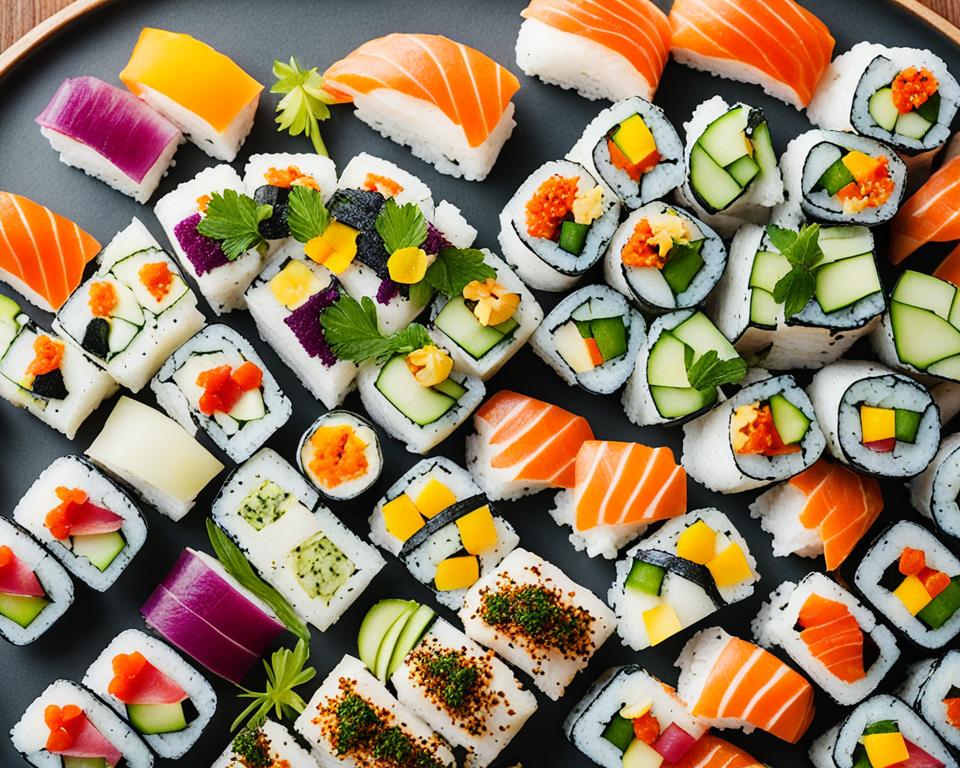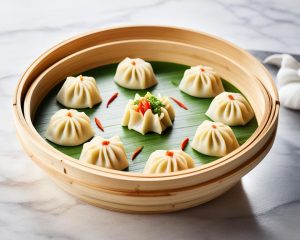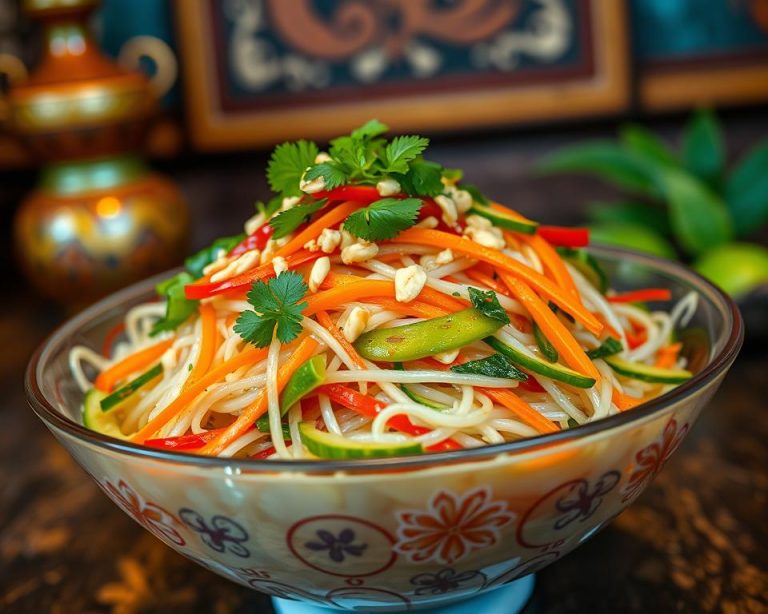Nori sushi is a key part of traditional Japanese cuisine. It showcases the sweet, savory, and salty tastes in seaweed-wrapped rice rolls. This article will look at its deep history, what it’s made from, and how it’s created. We’ll show you how to make real Japanese sushi rolls. You’ll learn about its good effects on health, what it means in culture, and how it’s enjoyed. If you love sushi or are just starting to, this guide is perfect for you. It leads you through the lively world of traditional Japanese rolls.
Read more interesting information at ::blackcerenity
What is Nori Sushi?
Nori sushi, or maki sushi, is a type of sushi from Japan. It’s made by wrapping sushi rice in dried seaweed. This tradition started in the Edo period and soon became a well-loved dish.
Definition and Origins
Nori seaweed is key to the taste and look of nori sushi. It has a green-black color and tastes savory. This makes nori sushi perfect for adding all kinds of toppings. From raw fish to veggies, it’s a favorite in Japan.
Nori Seaweed Wraps
Dried and roasted nori seaweed wraps the sushi. It gives a nice, umami flavor and a crunchy feel. This complements the sushi rice and the different fillings well.
Varieties of Nori Sushi
Nori sushi comes in many types, such as the California roll and the spicy tuna roll. There’s also the rainbow roll and the Philadelphia roll. These are just a few examples of the many kinds you can try. They show how creative and diverse sushi can be.
Ingredients for Nori Sushi
The base of nori sushi is sushi rice made with Japanese short-grain rice, rice vinegar, sugar, and salt. This mix gives the rice its special taste. Nori sheets are the dried seaweed used to wrap the sushi. It adds a unique look and flavor.
Sushi Rice
Sushi rice is key to nori sushi, forming the roll’s center. It’s made from a special short-grain Japanese rice. Then, it’s flavored with rice vinegar, sugar, and salt. This creates a wonderful mix of sweet, sour, and salty.
Nori Sheets
Next come the nori sheets, made by drying and roasting seaweed. They wrap around the sushi rice and fillings. These sheets are dark green and bring a savory taste. They also add a nice crunch to the roll.
Fillings and Toppings
What goes inside nori sushi is up to you, offering lots of variety. You can choose from raw fish like tuna, salmon, or yellowtail. Or go for cooked fillings such as crab, avocado, and cucumber. There are also pickled veggies to pick from. The mix of the rice, nori, and fillings makes a perfect balance in each roll.
nori sushi
Nori sushi, or maki sushi, comes from Japan. It’s made of thin, round rolls of rice. These rolls are wrapped in a crispy seaweed called nori. This seaweed adds a rich, savory taste.
Traditional Sushi Rolling Techniques
Authentic nori sushi making is a complex art from Japan. It’s been refined over hundreds of years. The first step is getting the bamboo sushi mat ready.
Preparing the Bamboo Mat
This mat is wrapped in plastic. It stops the rice from sticking. This makes sure the rice is rolled perfectly, keeping the sushi’s delicate look.
Rice Spreading and Nori Placement
Once the mat is set, the special sushi rice is spread on the nori. A bit of space is left at the top. This makes sure the roll comes out smooth, showing off true sushi rolling techniques.
Fillings and Rolling
The fillings go in the middle of the rice and nori. Then, with the help of the bamboo mat, the sushi is rolled up tight. This step shapes the roll perfectly, key to its great look.
Finally, the roll is gently squeezed and molded. This makes it look neat and solid, a sign of a chef’s skill in using the sushi rolling techniques.
Popular Nori Sushi Rolls
Nori sushi, also known as maki sushi, offers many tasty roll options. Each roll has its own special taste and look. For instance, the California roll mixes crab, avocado, and cucumber. Then there’s the spicy tuna roll, pairing raw tuna with a kick of chili sauce. The rainbow roll brings together various colorful fish toppings. And don’t miss the Philadelphia roll, filled with smoked salmon, cream cheese, and scallions. Sushi like these has gained worldwide popularity, proving how diverse and innovative Japanese cuisine can be.
| Popular Nori Sushi Rolls | Key Ingredients |
|---|---|
| California Roll | Crab, avocado, cucumber |
| Spicy Tuna Roll | Raw tuna, spicy chili sauce |
| Rainbow Roll | Assortment of raw fish toppings |
| Philadelphia Roll | Smoked salmon, cream cheese, scallions |
Presentation and Plating
When it comes to nori sushi, how it looks makes a big difference. Chefs top their rolls with pretty extras like pickled ginger, spicy mayo, or sesame seeds. These not only look good but also taste great with the sushi.
Garnishing and Sauces
Adding the right garnishes and sauces can really make nori sushi pop. Chefs might drizzle eel sauce or spicy mayo on top. They also sprinkle pickled ginger or sesame seeds for color and crunch.
Artistic Arrangement
There’s an art to placing nori sushi on the plate. Chefs use special methods to arrange the rolls. That could be fanning them out, making neat designs, or adding decorative touches. They turn nori sushi into a beautiful dish that enchants both the eyes and the taste buds.

Health Benefits of Nori Sushi
Nori sushi isn’t just tasty; it’s packed with health benefits. The seaweed used in nori is filled with iodine, vitamin A, vitamin C, and iron. This makes it rich in essential vitamins and minerals. The sushi rice gives you complex carbohydrates, which offer long-lasting energy.
Nutritional Value
Nori sushi has low calories and is low fat, especially with raw fish or veggies inside. This makes it a great option for those focused on being healthy. It combines well with other foods, making it nutritious for anyone who eats it. Nori sushi completes a balanced diet beautifully.
Low-Calorie and Low-Fat
The low-calorie and low-fat feature of nori sushi is perfect for those who want to eat healthier. Its mix of seaweed, rice, and lean protein gives you a meal that’s good and good for you. It’s a great choice over high-fat sushi types or fried meals. You can enjoy it without worrying too much about your calories or fat intake.
| Nutrient | Nori Seaweed | Sushi Rice | Lean Protein Fillings |
|---|---|---|---|
| Calories | 9 calories per sheet | 110 calories per 1/2 cup | 20-30 calories per ounce (e.g., tuna, salmon) |
| Fat | Negligible | 0.4 grams per 1/2 cup | 0-3 grams per ounce (e.g., tuna, salmon) |
| Protein | 1 gram per sheet | 2 grams per 1/2 cup | 4-7 grams per ounce (e.g., tuna, salmon) |
| Vitamins and Minerals | Rich in iodine, vitamin A, vitamin C, iron | Source of complex carbohydrates | Dependent on specific fillings |
Nori Sushi in Japanese Cuisine
Nori sushi is a key part of Japan’s food culture, going back to the Edo period. It was first loved as a quick meal on the go. Made with nori seaweed, it shows the strong heritage of nori sushi.
Cultural Significance
Nori sushi varies across Japan, reflecting each area’s tastes and traditions. Places like the Kansai region are famous for making big futomaki rolls. On the other hand, the Kanto region is all about their thin and elegant maki sushi. This variety highlights the rich diversity of nori sushi in Japanese food culture.
Regional Variations
The lasting appeal of nori sushi demonstrates Japan’s commitment to its food heritage. From the old days of Edo to now, nori sushi is a big part of Japan’s food scene. It proves Japan’s deep love for its food traditions and history.
Sushi Etiquette
Enjoying nori sushi in a traditional Japanese way has some key sushi etiquette to follow. You should know the right way to hold chopsticks and the best order for eating. For example, eat sushi in one bite with chopsticks. Don’t use your hands. Place the ginger garnish on the plate’s edge, not on the sushi. When dipping sushi in soy sauce, turn it over. Don’t put too much soy sauce or fully dip the rice.
Learning these japanese dining customs makes eating nori sushi more enjoyable. It also shows respect for Japanese food customs.
| Sushi Etiquette Guideline | Explanation |
|---|---|
| Holding Chopsticks | Sushi should be eaten with chopsticks, held at the upper third of the sticks. |
| Single-Bite Consumption | Sushi is meant to be eaten in a single bite, without the use of one’s hands. |
| Ginger Placement | The pickled ginger garnish should be placed on the side of the plate, not directly on the sushi. |
| Soy Sauce Dipping | Sushi should be dipped into the soy sauce with the topping side down, avoiding fully submerging the rice. |
Knowing these dining etiquette rules helps love and respect nori sushi even more. It shows honor for Japan’s food culture.

Pairing Nori Sushi with Beverages
The flavors of nori sushi match well with traditional Japanese drinks. Sake, a Japanese rice wine, is loved with nori sushi. It fits well because it balances the rich sushi taste with its own. This makes every bite a delightful experience.
Japanese Sake
Sake and nori sushi are a timeless pair. Sake’s fizzy, tangy touch contrasts the sushi’s complexity. Together, they create a perfect balance, enhancing the meal.
Green Tea
Green tea is another favorite with sushi. It brings a crisp, slightly bitter taste that complements the seafood. The tea’s mild boldness purifies the taste buds, making each sushi piece stand out.
Pairing nori sushi with the right drinks enriches the dining experience. It shows the deep relationship between taste and tradition in Japan.
Making Nori Sushi at Home
Think making nori sushi is hard? It’s totally doable at home. You just need the right sushi making tools and a guide. Then, you can make tasty nori sushi rolls on your own.
Essential Tools
To make nori sushi at home, you need some basic tools. These are a sharp knife, a bamboo sushi mat, and a rice cooker or pot. These help to get your homemade sushi just right.
Step-by-Step Guide
Making nori sushi goes step by step. First, cook sushi rice and add vinegar to make it sticky. Then, put a nori sheet on the bamboo mat and spread rice on it, leaving the top edge rice-free.
After, add your favorite fillings in the middle. Now, roll it up tightly from the bottom. Make it look like a cylinder. Squeeze the roll gently to keep it all together.
Learning to make nori sushi is fun. With a little practice, anyone can enjoy making and eating their own sushi rolls.
Nori Sushi in Restaurants
Nori sushi is winning over diners worldwide. It’s found in both traditional Japanese spots and new, creative places. At authentic Japanese eateries, the making and serving of nori sushi follow a rich tradition with great care.
Authentic Japanese Sushi Bars
In these places, skilled chefs make each nori sushi roll with care. They often use local flavors and fresh seasonal ingredients. This way, they highlight the dish’s true spirit. Every step, from preparing the rice to wrapping it in nori seaweed, is done meticulously.
Fusion and Modern Twists
Then, there are the fusion and modern takes on nori sushi. Here, chefs mix the classic with unique, global tastes and methods. The result? Dishes full of surprising flavors that please anyone’s taste. You can enjoy both classic nori sushi and innovative options at eateries all over the world.















+ There are no comments
Add yours